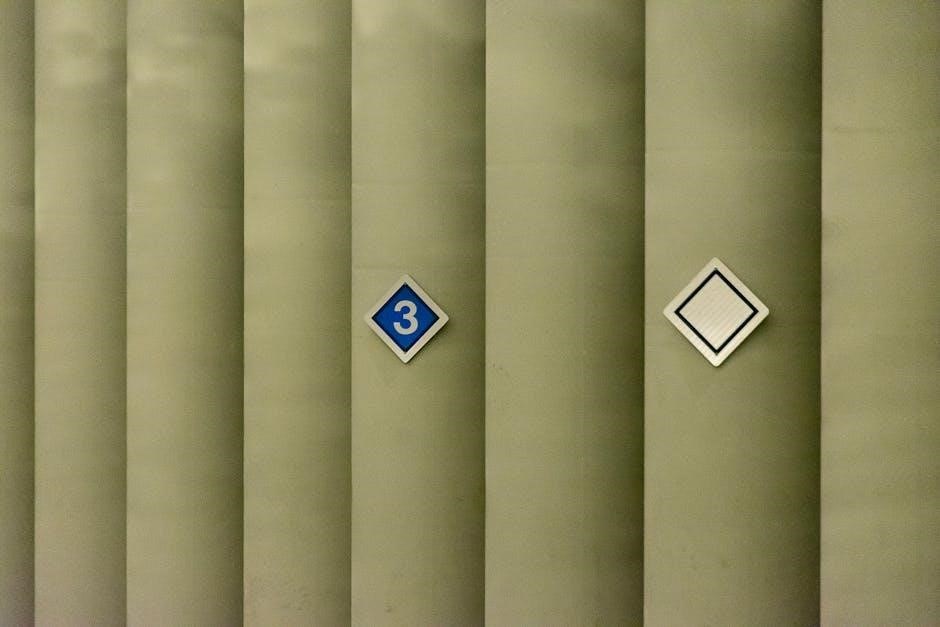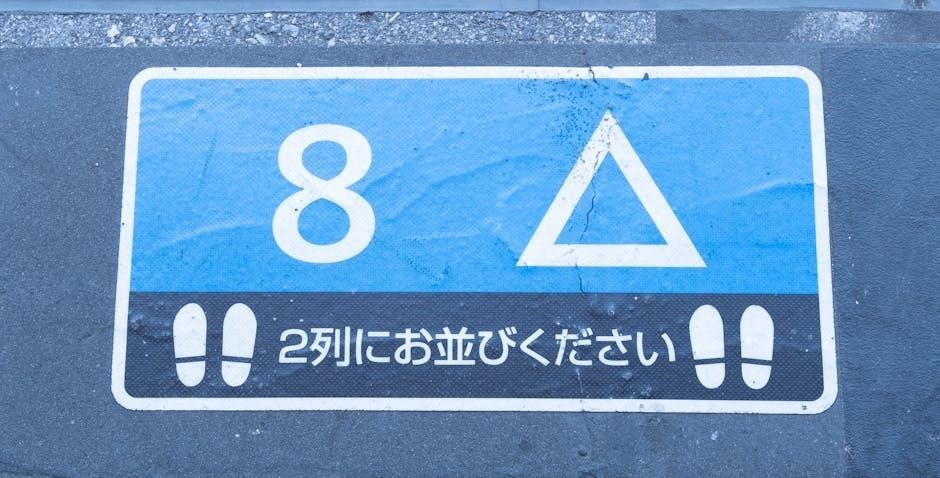Out of order signs are essential for communicates that a facility or equipment is unavailable. They ensure safety, reduce confusion, and maintain order in public spaces or workplaces.
1.1 Importance of Out of Order Signs
Out of order signs are crucial for ensuring safety, preventing accidents, and minimizing disruptions. They clearly communicate that a facility or equipment, such as restrooms or elevators, is unavailable, reducing confusion and potential hazards. These signs also help protect businesses and organizations from liability by providing clear notice of outages. Additionally, they guide users to alternative options, maintaining smooth operations. Their importance lies in their ability to enforce compliance, prevent misuse, and maintain order in public or workplace settings. Standardized and visible signs ensure consistency and effectiveness in conveying critical information. They are essential for fostering a safe and organized environment.
1.2 Brief History and Evolution
Out of order signs have evolved from simple handwritten notes to standardized, professionally designed indicators. Historically, such signs were basic and manually created, often lacking uniformity; The digital age brought printable PDF formats, enabling easy customization and widespread use. Early versions were limited to basic text, while modern designs incorporate visuals and compliance standards. The shift from physical notices to downloadable templates has enhanced accessibility and consistency. This evolution reflects advancements in communication and technology, ensuring clearer and more effective messaging. Today, these signs are indispensable in maintaining order and safety across various settings, from workplaces to public spaces.

Types of Out of Order Signs
Out of order signs have evolved from simple handwritten notes to standardized, professionally designed indicators. Historically, such signs were basic and manually created, often lacking uniformity. The digital age brought printable PDF formats, enabling easy customization and widespread use. Early versions were limited to basic text, while modern designs incorporate visuals and compliance standards. The shift from physical notices to downloadable templates has enhanced accessibility and consistency; This evolution reflects advancements in communication and technology, ensuring clearer and more effective messaging. Today, these signs are indispensable in maintaining order and safety across various settings, from workplaces to public spaces.
2.1 Restroom Out of Order Signs
Restroom out of order signs are crucial for informing users about unavailable facilities. These signs are commonly used in public spaces, offices, and restaurants to indicate when a restroom is closed for maintenance or repairs. They often feature clear text, such as “Restroom Out of Order” or “Sorry, This Restroom is Temporarily Closed,” and may include arrows directing users to alternative facilities. Printable PDF versions are widely available, offering standard sizes like 8.5 x 11 inches, which fit both US letter and A4 paper. These signs help maintain hygiene standards and prevent inconvenience, ensuring smooth operations in busy environments. They are easy to print and display.
2.2 Elevator Out of Order Signs
Elevator out of order signs are vital for ensuring safety and preventing accidents in buildings with elevators. These signs clearly indicate when an elevator is not operational, helping to avoid confusion and potential hazards. Printable PDF versions are widely available, offering standard sizes like 8.5 x 11 inches, which fit both US letter and A4 paper. Many designs include bold text, such as “Elevator Out of Order” or “Temporarily Out of Service,” and may provide arrows or instructions directing users to alternative elevators or stairways. These signs are essential for maintaining smooth operations in offices, malls, and other public spaces with elevator access.
2.3 Generic Out of Order Signs
Generic out of order signs are versatile and suitable for various equipment or facilities. These signs are not specific to any particular item, making them ideal for temporary or unexpected situations. Printable PDF versions are available in standard sizes like 8.5 x 11 inches, fitting both US letter and A4 paper. Many designs feature universal messages such as “Out of Order” or “Temporarily Unavailable,” often accompanied by simple visuals. This flexibility allows users to apply them to restrooms, vending machines, printers, or any other equipment needing attention. They provide a quick, professional way to communicate service interruptions, ensuring clarity and minimizing inconvenience for users.

Where to Find Out of Order Signs
Out of order signs are widely available online as printable PDFs. Official sources and third-party websites offer free downloads, ensuring easy access for various needs and locations.
3.1 Official Sources for Download
Official sources provide reliable and standardized out of order sign templates. Websites like government portals or reputable safety organizations offer free downloadable PDFs, ensuring compliance with regulations. These templates are designed for clarity and professionalism, making them suitable for public spaces, workplaces, and facilities. They often include customizable fields for specific details, such as the reason for the outage or contact information. Downloading from official sources guarantees the signs meet legal and safety standards, reducing liability concerns. Users can print these templates on standard paper sizes, like US letter or A4, ensuring compatibility with most printers. This accessibility makes official sources a top choice for quick and efficient sign solutions.

3.2 Third-Party Websites
Third-party websites offer a wide range of printable out of order signs in PDF format, catering to diverse needs. These platforms provide customizable templates for restrooms, elevators, and generic use, ensuring versatility. Many sites offer free downloads, while others provide premium designs for a fee. The signs are typically easy to download and print, compatible with standard paper sizes like US letter and A4. Users can choose from various designs, fonts, and color schemes to match their specific requirements. However, it’s important to verify the reliability and compliance of these sources to ensure the signs meet local regulations and professional standards.
How to Customize Out of Order Signs
Customizing out of order signs is straightforward. Add specific text or modify templates to suit your needs. Use design software or online tools to personalize messages, ensuring clarity and visibility. Choose fonts and colors that align with your brand or environment for a professional look. Printable PDFs allow easy editing before printing, making it simple to tailor signs for restrooms, elevators, or generic use. This flexibility ensures the signs remain effective and visually consistent while addressing specific situations and maintaining a polished appearance.
4.1 Adding Custom Text
Adding custom text to out of order signs is a simple process that enhances clarity and specificity. Use design software or online editors to modify pre-made templates. Include details like the reason for the outage, expected repair time, or alternative options. Ensure the text is clear, concise, and easy to read from a distance. Choose a font size and style that aligns with the sign’s design and purpose. Custom text can also include contact information for maintenance or customer service, providing users with additional resources. This personalization ensures the sign effectively communicates the necessary information while maintaining a professional appearance. PDF formats allow easy editing and printing of customized signs for immediate use in various settings like restrooms, elevators, or vending machines. By tailoring the message, organizations can better manage expectations and reduce inconvenience for users.
4.2 Using Templates
Using templates for out of order signs simplifies the creation process, saving time and effort. Pre-designed templates are widely available online, offering various styles and formats to suit different needs. Many templates are free and downloadable in PDF format, making them easy to print. They often include standard phrases like “Out of Order” or “Temporarily Unavailable,” which can be customized. Templates ensure consistency in design and messaging, making the signs professional and clear. Websites offer templates for specific uses, such as restrooms, elevators, or vending machines. By using templates, users can quickly create and print signs without needing advanced design skills, ensuring effective communication and compliance with standards.

Printing Out of Order Signs
Printable PDF signs are available in standard US letter size (8.5 x 11 inches) and fit A4 paper sizes. Templates are downloadable for instant use, ensuring clarity and professionalism.
5.1 Printing Tips
For optimal results, print out of order signs on high-quality paper using a reliable printer. Ensure the PDF is printed in actual size to maintain clarity. Use bright colors for visibility and laminate signs for durability. Choose paper size according to your needs, with US letter (8.5 x 11 inches) being the standard. A4 size is also compatible for international use. Avoid scaling or resizing the template to preserve text and design integrity. Print on one side to prevent ink bleed-through. Test the print on plain paper first to confirm alignment and quality before using premium stock.
5.2 Paper Size and Format
Most out of order signs are designed for standard US letter size (8.5 x 11 inches) and are also compatible with A4 paper, ensuring versatility for international use. The PDF format ensures consistent printing quality across different devices. Choose portrait orientation for visibility and readability. Ensure margins are set correctly to avoid cropping essential text or symbols. For larger signs, consider scaling the design or using poster-sized paper. Always preview the PDF before printing to confirm the layout matches your paper size. This ensures the sign is clear, professional, and easily understood by everyone who sees it.

Usage of Out of Order Signs
Place signs prominently near malfunctioning equipment to alert users immediately. Ensure visibility at eye level for clarity. Use them temporarily or permanently, depending on the situation, to maintain order and safety in public or workplace environments.
6.1 Placement and Visibility
Proper placement of out-of-order signs is crucial for effectiveness. They should be positioned near the affected equipment or area, ensuring clear visibility at eye level. This immediate notification helps prevent misuse and reduces confusion. For restrooms or elevators, place signs on doors or access points. In public spaces, visibility from a distance is key. Use bright colors and bold text to capture attention quickly. Ensure the sign is securely fastened to avoid tampering or accidental removal. Visibility enhances compliance and safety, making it easier for users to understand the situation and take appropriate action.
6.2 Temporary vs. Permanent Use
Out-of-order signs can be used for both temporary and permanent situations. Temporary signs are ideal for short-term issues, such as maintenance or repairs, and are often printed on paper or lightweight materials for easy removal. Permanent signs, however, are designed for long-term use, such as when equipment is permanently out of service. Durable materials like laminated paper or plastic are recommended for permanent signs to withstand environmental factors. Understanding the duration of the issue helps choose the right material and design, ensuring the sign remains effective and clear over time. This distinction is crucial for maintaining clarity and safety in public spaces.
6.3 Compliance with Regulations
Out-of-order signs must comply with local and international regulations to ensure accessibility and clarity. ADA guidelines require clear font styles, high-contrast color schemes, and the inclusion of symbols like the international symbol of accessibility. Printable PDF signs often feature standardized designs that meet these requirements, ensuring they are universally understood. Compliance is crucial for maintaining safety, avoiding legal issues, and providing equal access to information for all individuals. By using pre-designed templates, users can easily adhere to regulatory standards without additional effort. This ensures the signs are both effective and legally appropriate for public or workplace environments.
6.4 Handling Emergency Situations
Out-of-order signs play a critical role in managing emergency situations by clearly indicating unavailable facilities or equipment. In emergencies, such as a malfunctioning fire alarm or elevator, these signs help prevent accidents and guide people to safety. Printable PDF signs are easily customizable to include emergency contact details or alternative routes, ensuring quick communication. Their visibility and clarity are essential for maintaining order during crises. By using standardized designs, these signs comply with safety regulations and provide immediate, understandable instructions. This ensures that emergencies are handled efficiently, minimizing risks and ensuring the safety of everyone involved. They are indispensable in urgent scenarios.
Design Considerations
Effective designs for out-of-order signs include high-contrast colors, simple fonts, and clear symbols to ensure visibility and readability. Standardized designs enhance professionalism and compliance with safety standards.
7.1 Color Schemes
Color schemes play a crucial role in the visibility and effectiveness of out-of-order signs. Bright colors like red and yellow are commonly used to grab attention immediately. These colors are often associated with caution or danger, making them ideal for signaling that something is out of service. Additionally, high-contrast combinations, such as black text on a yellow background, enhance readability from a distance. Consistent use of these color schemes ensures that signs are easily recognizable and comply with safety standards. Proper color selection helps maintain a professional appearance while conveying the necessary information clearly and effectively.
7.2 Font Styles
Font styles for out-of-order signs should prioritize clarity and readability. Sans-serif fonts like Arial or Helvetica are recommended due to their simplicity and legibility from a distance. Bold text can enhance visibility, ensuring the message stands out. Font size should be large enough to be easily readable, even from afar, with proper spacing to avoid clutter. Consistent font styles across all signs maintain a professional appearance and ensure messages are universally understood. These design choices help meet safety standards and effectively communicate the out-of-order status of equipment or facilities. Clear typography is essential for conveying critical information quickly and accurately.
7.3 Visual Symbols
Visual symbols on out-of-order signs enhance communication, especially for non-English speakers or those with limited literacy. Common symbols include a large “X” or a red circle with a line through it, universally recognized as indicating something is not in use. Icons like restroom symbols or elevator graphics help quickly identify the affected area. These visuals grab attention and convey the message faster than text alone. High-contrast colors and simple designs ensure accessibility for visually impaired individuals. Symbols should be consistent across all signs to avoid confusion. Combining clear text with relevant symbols ensures the message is understood by everyone, making the signs more effective and accessible.

Examples of Out of Order Signs
Common examples include restroom, elevator, and generic out-of-order signs. These are widely used in offices, malls, and hotels to inform users of unavailability and redirect them appropriately.
8.1 Restroom Out of Order Example
A restroom out-of-order sign is a clear indicator that a bathroom is unavailable for use. These signs are commonly used in public spaces, offices, and malls to redirect users to functional facilities. They often feature bold text, such as “RESTROOM OUT OF ORDER” or “PLEASE USE ALTERNATIVE FACILITIES,” and may include visual symbols for universal understanding. The signs are typically printed in PDF format on standard letter-sized paper, making them easy to download and print. Many designs incorporate red or yellow color schemes to grab attention and ensure visibility. They can be customized with additional information, such as the reason for closure or alternative options.
8.2 Elevator Out of Order Example
An elevator out-of-order sign is crucial for notifying users of unavailable service. These signs are often displayed in high-traffic areas like office buildings, malls, and hospitals. They typically feature bold text such as “ELEVATOR OUT OF ORDER” or “PLEASE USE STAIRS OR ALTERNATIVE ELEVATORS.” Many designs include universal symbols, such as an “X” over an elevator icon, to ensure clarity. The signs are usually printed in PDF format on standard letter-sized paper, making them easy to download and post. They may also include additional details like the expected duration of maintenance or contact information for assistance. Customizable templates allow for tailored messaging to suit specific needs.

Cost and Accessibility
Many printable PDF out-of-order signs are free, offering cost-effective solutions. They are widely accessible for download, ensuring easy use for various users and locations.
9.1 Free vs. Paid Options
Free printable PDF out-of-order signs are widely available for personal or workplace use, offering a cost-effective solution. They are simple to download and print, making them accessible to everyone. Paid options, however, provide more customization, higher resolution, and unique designs, catering to professional settings. Free signs are ideal for basic communication, while paid versions offer enhanced features for specific needs. Both options ensure clear messaging, but the choice depends on the desired level of customization and durability.
9.2 Accessibility for Different Users
Printable out-of-order signs are designed to be accessible for a wide range of users. They are available in standard formats like PDF, ensuring compatibility with most devices. The clear, readable text and universal symbols make them understandable for people with varying levels of literacy or visual impairments. Many signs are also customizable, allowing adjustments in font size or color to improve visibility. Additionally, translations into multiple languages can be included to cater to diverse audiences. This accessibility ensures that the message is conveyed effectively to all users, regardless of their background or abilities.
Legal Considerations
Legal considerations for out of order signs involve compliance with local regulations, ensuring proper wording, and visibility standards to avoid liability issues and maintain safety.
10.1 Liability Issues
Liability issues arise if out of order signs are unclear or improperly displayed, potentially leading to accidents or injuries. Proper signage ensures legal compliance, protecting property owners from lawsuits. Clear and visible signs help prevent claims of negligence. Employers must ensure signs meet safety standards to avoid legal repercussions. Failure to display signs can result in fines or legal action. Therefore, it’s crucial to use standardized, easily understandable signs to minimize liability risks effectively.
10.2 Compliance with Local Laws
Compliance with local laws is crucial when using out of order signs. Many jurisdictions have specific requirements for signage design, size, and placement. Printable PDF signs must adhere to these regulations to ensure legal compliance. Standardized templates often meet local standards, making them a reliable choice. Customizable options allow adjustments to fit specific legal requirements. Using compliant signs helps avoid fines and legal issues. Always verify local regulations before printing and posting signs; Compliance ensures clarity and consistency, reducing potential misunderstandings. Proper signage not only informs users but also protects the responsible party from legal repercussions. Adherence to local laws is essential for effectiveness.
Additional Resources
Explore further reading, tools, and software for creating customizable out of order signs. Utilize design platforms like Canva or Adobe Illustrator for tailored templates and professional designs.
11.1 Further Reading
For more detailed information, explore articles on design platforms like Canva or Adobe Illustrator, which offer tutorials on creating custom out of order signs. Visit websites specializing in workplace safety and signage regulations to ensure compliance. Additionally, check out blogs focusing on facility management for insights into effective sign placement and usage. Many online resources provide step-by-step guides for printing and laminating signs. These materials can help you create professional-looking signs tailored to your specific needs. Ensure your designs meet local laws and accessibility standards for clear communication. Further reading will enhance your understanding of best practices in signage implementation.
11.2 Tools and Software
Utilize design tools like Canva, Adobe Illustrator, or Google Docs to create customizable out of order signs. PDF editors such as Adobe Acrobat or online platforms like PDFescape can help finalize and print your designs. These tools offer templates and editing features to ensure your signs are clear and professional. Additionally, websites like Template.net and SignMaker.net provide pre-designed templates for various purposes. Online printers like Vistaprint also offer custom signage solutions. These resources streamline the process of designing and printing out of order signs, ensuring they are both functional and visually appealing for your specific needs.